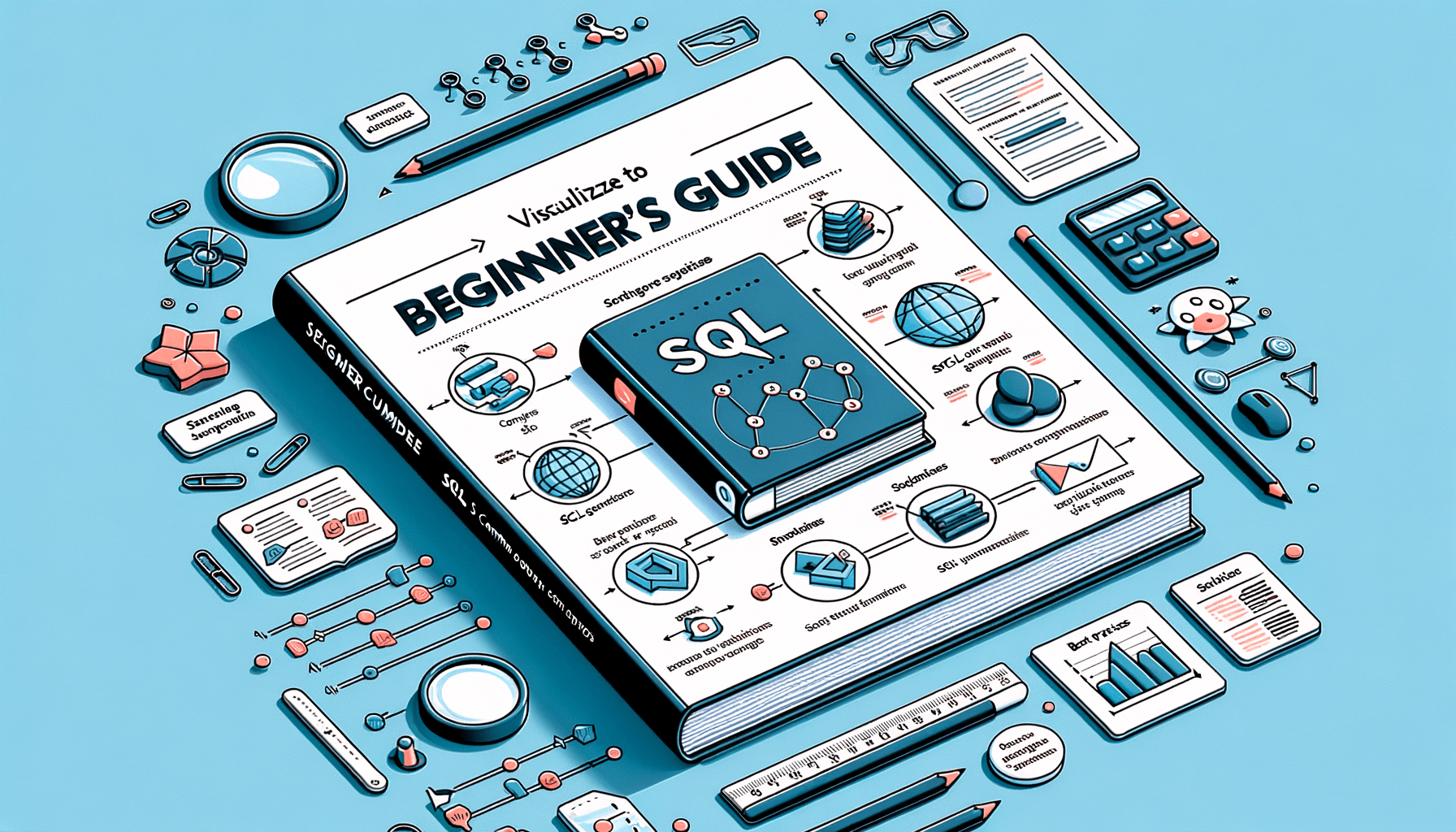A big variety of articles and resources

Mastering SQL: A Comprehensive Guide for IT Professionals
 Sia Author and Instructor
Learn SQL
Sia Author and Instructor
Learn SQL
9 minute read
Understanding SQL Fundamentals
SQL (Structured Query Language) is the universal language of databases. It allows you to communicate with and manipulate data stored in relational databases. Mastering SQL fundamentals is crucial for anyone looking to unlock the potential of data science and database management.
Basic SQL Syntax
The first step in learning SQL is to understand its basic syntax. This includes commands like SELECT, INSERT, UPDATE, and DELETE, which form the building blocks of data manipulation. With practice, you will become proficient in creating these simple yet powerful SQL queries.
Data Types and Structures
In SQL, data types define the kind of data that can be stored in a table. Common data types include INT, VARCHAR, DATE, and BOOLEAN. Understanding these data types is essential for designing efficient databases and ensuring data integrity.
Primary Keys and Indexes
Primary keys are unique identifiers for records in a table, ensuring that each record can be uniquely identified. Indexes, on the other hand, are used to speed up the retrieval of data. Both are fundamental concepts that play a crucial role in database design and performance optimization.
Gaining proficiency in SQL enables you to analyze data, extract valuable insights, and make informed decisions that drive business success.
Advanced Query Techniques
Subqueries and Nested Queries
Subqueries, also known as inner queries or nested queries, are essential for mastering SQL: a comprehensive guide to advanced SQL techniques for data analysis. They allow you to retrieve data based on the results of another query, making it possible to solve complex data retrieval tasks efficiently. Learning to use subqueries effectively can significantly enhance your SQL capabilities.
Common Table Expressions (CTEs)
Common Table Expressions (CTEs) provide a way to create temporary result sets that can be referenced within a SELECT, INSERT, UPDATE, or DELETE statement. CTEs are particularly useful for breaking down complex queries into more manageable parts, improving readability and maintainability. They are a powerful tool for any data professional looking to streamline their SQL operations.
Window Functions
Window functions perform calculations across a set of table rows that are somehow related to the current row. Unlike aggregate functions, window functions do not cause rows to become grouped into a single output row. Instead, the rows retain their separate identities. Window functions are crucial for advanced data analysis, enabling tasks such as running totals, moving averages, and ranking.
Mastering these advanced query techniques is essential for data professionals aiming to perform complex data analysis and optimize SQL performance.
Database Design and Normalization
Normalization Forms
Normalization is a process used to organize a database into tables and columns. The main goal is to reduce redundancy and improve data integrity. Applying appropriate constraints helps maintain data consistency and accuracy. There are several normal forms, each with specific requirements:
- First Normal Form (1NF): Ensures that each column contains atomic (indivisible) values and each record is unique.
- Second Normal Form (2NF): Achieved when the table is in 1NF and all non-key columns are fully dependent on the primary key.
- Third Normal Form (3NF): Achieved when the table is in 2NF and all the columns are non-transitively dependent on the primary key.
Entity-Relationship Modeling
Entity-Relationship (ER) modeling is a crucial step in designing a database schema. It involves identifying the entities, their attributes, and the relationships between them. This model serves as a blueprint for constructing the database schema and helps in understanding the data flow and structure.
Designing Efficient Schemas
Designing an efficient database schema is essential for optimal performance. Key considerations include:
- Database schema design should focus on minimizing redundancy and ensuring data integrity.
- Use of appropriate data types and constraints like NOT NULL, UNIQUE, and FOREIGN KEY.
- Indexing strategies to speed up query performance.
A well-designed schema not only improves performance but also simplifies maintenance and scalability.
Understanding these principles is vital for creating robust and efficient databases.
SQL Performance Optimization
Indexing Strategies
Mastering the basics of indexing is crucial for effective database querying. Indexes can significantly speed up data retrieval, but they also come with overhead. It's essential to understand the different types of indexes, such as B-tree and hash indexes, and when to use them. Proper indexing can make a substantial difference in query performance.
Query Optimization Techniques
Optimization tips include writing efficient SQL joins, unions, and filtering techniques. Subqueries and query crafting are also vital for performance and clarity. Using execution plans to analyze and improve query performance is another key aspect. Understanding how the database engine processes queries can lead to more efficient SQL code.
Database Maintenance
Regular database maintenance is essential for optimal performance. This includes tasks like updating statistics, rebuilding indexes, and archiving old data. A well-maintained database ensures that queries run smoothly and efficiently. Implementing automated maintenance tasks can save time and reduce the risk of human error.
Consistent database maintenance is a proactive approach to ensure long-term performance and reliability.
SQL in Different Database Systems
SQL Server
SQL Server is a relational database management system developed by Microsoft. It is widely used in enterprise environments for its robust performance, security features, and integration with other Microsoft products. Essential SQL commands for system administrators include creating databases, managing users, and optimizing queries. SQL Server also supports advanced analytics and reporting services, making it a comprehensive solution for data management.
MySQL
MySQL is an open-source relational database management system that is popular for web applications and small to medium-sized businesses. It is known for its speed, reliability, and ease of use. MySQL supports a wide range of SQL commands and is compatible with various programming languages. To gain proficiency, one can learn through books, online courses, and tools like MySQL Workbench. Engaging in communities for continuous learning and staying updated with SQL trends is also beneficial.
PostgreSQL
PostgreSQL is an advanced, open-source relational database system known for its extensibility and standards compliance. It supports complex queries, foreign keys, triggers, and updatable views. PostgreSQL is often used in applications that require complex transactions and high concurrency. Its support for JSON and other non-relational data types makes it a versatile choice for modern applications. For those looking to master PostgreSQL, it is essential to understand its unique features and capabilities.
Securing SQL Databases
User Authentication and Authorization
Implementing robust user authentication and authorization mechanisms is crucial for protecting your SQL databases. By ensuring that only authorized users have access to specific data and operations, you can significantly reduce the risk of unauthorized access and data breaches. Applying appropriate constraints helps maintain data consistency and accuracy.
Data Encryption
Data encryption is a vital practice for safeguarding sensitive information stored in your SQL databases. Encrypting data at rest and in transit ensures that even if unauthorized parties gain access to the data, they cannot read it without the decryption keys. This practice is essential for maintaining data privacy and compliance with regulatory requirements.
SQL Injection Prevention
SQL injection attacks are a common threat to SQL databases, where malicious actors exploit vulnerabilities in your SQL code to execute unauthorized queries. To prevent SQL injection, it is important to use parameterized queries, validate user inputs, and employ proper error handling. These measures help protect your database from being compromised by malicious SQL code.
In today’s data-driven world, proficiency in Structured Query Language (SQL) is not just a valuable skill but a necessity for anyone looking to excel in the realms of data analysis, database management, and software development. SQL serves as the backbone of many critical systems, enabling users to interact with databases, retrieve information, and perform various operations with ease and efficiency. As such, embarking on a journey to master SQL can open up a plethora of opportunities for individuals and organizations alike.
Practical SQL Applications
SQL is not just a theoretical tool; its true power is realized through practical applications in various domains. This section explores some of the most impactful ways SQL can be applied in real-world scenarios.
In today's data-driven world, mastering SQL is essential for anyone looking to advance their technical skills and career prospects. Our comprehensive courses, supported by AI-driven guidance, are designed to help you become a SQL specialist. Don't miss out on this opportunity to enhance your knowledge and achieve your goals. Visit our website to learn more and get started today!
Conclusion
Mastering SQL is an essential skill for data professionals and software engineers alike. This comprehensive guide has provided you with the foundational knowledge and advanced techniques necessary to excel in SQL development. From understanding basic queries to optimizing complex joins, you now have the tools to manage, analyze, and manipulate data effectively. Whether you are just starting your journey or looking to refine your existing skills, the insights and practical exercises included in this guide will help you unlock the full potential of SQL. Continue to practice and explore, and you will find that SQL is not just a powerful tool, but an indispensable asset in your professional toolkit.
Frequently Asked Questions
What is SQL and why is it important?
SQL (Structured Query Language) is a standard programming language specifically designed for managing and manipulating relational databases. It is important because it allows for efficient querying, updating, and management of data, which is essential for data analysis, reporting, and various applications.
What are the basic components of SQL syntax?
The basic components of SQL syntax include clauses (such as SELECT, FROM, WHERE), expressions, predicates, and queries. These components are used to perform operations like data retrieval, insertion, updating, and deletion.
How do primary keys and foreign keys work in SQL?
A primary key is a unique identifier for a record in a table, ensuring that each record is unique. A foreign key is a field in one table that uniquely identifies a row of another table, creating a relationship between the two tables. This helps in maintaining referential integrity within the database.
What are subqueries and how are they used?
Subqueries are queries nested inside another query. They are used to perform operations that require multiple steps, such as filtering results based on a secondary query. Subqueries can be used in SELECT, INSERT, UPDATE, and DELETE statements to provide additional criteria for the main query.
What is database normalization and why is it important?
Database normalization is the process of organizing the fields and tables of a relational database to minimize redundancy and dependency. It is important because it ensures data integrity and optimizes the database's performance by reducing data anomalies and improving data consistency.
How can I prevent SQL injection attacks?
SQL injection attacks can be prevented by using parameterized queries, prepared statements, and stored procedures. Additionally, input validation and proper error handling are crucial to safeguard against malicious input that could compromise the database security.




